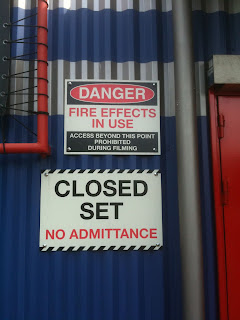As I mentioned in an earlier post, much of the food service available at Walt Disney Studios Park comes from stands and trucks positioned around the lot as if they were Craft Services or Catering at a working studio. There are two exceptions, however.
Restaurant des Stars, on the border between Production Courtyard and the Backlot, is an Art Deco homage to the studio commissaries of yore. This is the place where producers, agents, movie stars and studio executives would all meet to mingle and nosh during the lunch hour. The photographs on the wall depict some of the greats of Hollywood and European cinema who have frequented this establishment. Among them are none other than French culinary impresario August Gusteau and those brothers in fine dining, Remy and Emile, from the Disney-Pixar film Ratatouille.
These days, it seems Chef Remy is working the kitchen at Restaurant des Stars. From time to time, he even wanders into the dining room with one of his sous chefs, to see how the Guests are enjoying everything he's prepared.
On a personal note, I have never managed to see Remy in his appearances at Les Chefs de France at Epcot, but I rather enjoyed the fact that my first encounter with him was in an actual restaurant in actual France!
Of course, should Guests of Restaurant des Stars miss their opportunity to see and get a photograph with Remy, they can always pose with the little chef at this cute photo op just outside.
Moving out onto the Backlot, we come to Blockbuster Cafe, another example of dining the movie studio way. In this case, it's as though we're part of a huge cast shooting on the lot, where catering is brought to us for a lunch break on and around the set.
The environs surrounding Blockbuster Cafe include sets from popular films, such as The Chronicles of Narnia (above) and Les Parapluies de Cherbourg (The Umbrellas of Cherbourg, below), an award-winning French film from 1964 starring Catherine Deneuve.
Where things get really interesting, though, is inside the warehouse-style building of the Blockbuster Cafe. The loading dock at the side of the building is where the enormous sets are brought in for productions, and at the moment two major films are sharing the space: Pirates of the Caribbean and High School Musical.
No, that was not a typo. The interior decor of Blockbuster Cafe is divided between the two major film franchises. The ordering area and one of the dining rooms is the East High gymnasium set from High School Musical. There are pep rally banners, lockers, trophy cases and even a couple basketball hoops. You half expect Zac Efron to come running up for a slam dunk!
Meanwhile, the dining rooms on the opposite side of the building belong to a completely different production. Here, you can dine on the deck of the Black Pearl and admire some of the actual costumes used in the making of the Pirates of the Caribbean films. Don't spend too long eating, though. Lunch break will be over soon, and then it's on with the show!























































